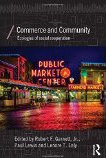Why State-Led Humanitarian Action Fails
An illustration of the Central Puzzle three years after a devastating 7.0 earthquake struck Haiti, the situation remains dire. Estimates suggest that more than 350,000 displaced Haitians continue to live in tent camps across the country. Half the camps lack onsite access to water and toilets, raising serious health and sanitary concerns. Despite billions of dollars in foreign aid and the efforts of thousands of NGOs and tens of thousands of aid workers, rebuilding remains sluggish.
Haiti is far from the only example of state-led humanitarianism gone awry. Foreign aid intended to alleviate poverty has largely failed and, still worse, in many cases caused additional harms to those who were already suffering. In 2005, the U.S. government failed to respond effectively to Hurricane Katrina, which occurred right in our own backyard. There have been many other such cases, both domestically and internationally. How can well-staffed and well-funded state-led humanitarian efforts, intended to help alleviate suffering, fail so badly? My new book, Doing Bad by Doing Good: Why Humanitarian Action Fails, answers this question both in the case of Haiti and in other instances of human suffering. I use the economic way of thinking to develop the economics of humanitarianism and focus on the constraints and realities facing humanitarians. This approach yields four key lessons regarding the limits of state-led humanitarian development. These insights will be of importance to anyone interested in addressing a range of humanitarian issues.
Lesson 1: Human vulnerability is a matter of economic development.
Issues of humanitarian crisis and suffering are ultimately issues of economic development and economic institutions which encourage or discourage productive entrepreneurship. To illustrate this, consider the relative damage done by the earthquakes in Haiti and Chile in 2010. The earthquake in Haiti measured 7.0 on the Richter scale, the equivalent of 2,000 Hiroshima bombs exploding simultaneously, whereas the earthquake in Chile measured 8.8 on the Richter scale, the equivalent of a million such bombs exploding simultaneously. Even though the earthquake that struck Chile was 500 times stronger than the one that struck Haiti, the death toll was dramatically different in these two countries and in a counterintuitive way. In Chile, the death toll was in the hundreds, whereas in Haiti the total number of deaths is estimated at 250,000. What explains the fact that Chile, which experienced a dramatically stronger earthquake, suffered significantly fewer deaths than Haiti?
A key part of the answer lies in the difference in the level of development between the two countries. Chile’s 2009 per capita income was about $14,800, while Haiti’s was $1,200. Furthermore, according to the Economic Freedom of the World project, in 2009 Chile ranked 7th (out of 141 countries ranked), whereas Haiti ranked 67th, indicating that it is more difficult for Haitians to engage in wealth-enhancing activities than it is for Chileans. Greater wealth, and the associated higher standard of living, comes with many benefits, including greater protection from the negative effects of natural disasters. The higher standard of living enjoyed by Chileans afforded them the opportunity to build better physical structures of all kinds, which helped lessen the damage done by the earthquake, and Chileans also benefited from better domestic post-disaster relief and recovery efforts. Haitians could not afford the same quality of physical structures and did not have access to the level of domestic spending on disaster recovery that existed in Chile. The importance of economic development for mitigating the negative effects of natural disasters can be generalized beyond Chile and Haiti, as countries with higher levels of development tend to suffer fewer deaths when natural disasters strike (Kahn 2005).
Since at least the post-World War II period, state-led humanitarian efforts have recognized the importance of economic development for alleviating and preventing suffering. The result is that the line between short-term relief efforts and long-term development efforts has become increasingly blurred, as many government humanitarian agencies attempt to address root causes of underdevelopment in the hope of closing the humanitarian-development gap. Private nonprofits, which have become increasingly dependent on state funds for survival, have followed suit in order to secure additional funding. In Haiti, for example, efforts by government agencies working both independently and through a host of international nongovernmental organizations are attempting to deliver both immediate assistance—such as food, water, and health care—and assistance for long-term development—infrastructure, institutional reform, etc. Effectively closing this gap entails not just providing short-term assistance but also generating longer-term development to permanently ameliorate suffering. Given this tendency, a central issue is whether those involved in humanitarian efforts know how to create economic development through foreign assistance. This leads to the second lesson regarding humanitarian action.
Lesson 2: Humanitarian action is unable to promote society-wide economic development.
Economic development requires a link between production and consumption or the use of scarce resources to produce things that people value. As F. A. Hayek pointed out, this process requires continual discovery as individuals experiment and discover new and better ways of doing things. Given this reality, there are three reasons why humanitarians cannot plan development.
For one, those involved in humanitarian efforts are unable to promote economic progress because they suffer from the planner’s problem, the inability of nonmarket participants to access relevant knowledge regarding how to allocate resources in a welfare-maximizing way in the face of a variety of competing, feasible alternatives. As Ludwig von Mises and Hayek demonstrated during the famous “calculation debate” over the feasibility of capitalism versus that of socialism, the only way for individuals to solve this problem is through market interactions. The relevant information and knowledge required for reallocating resources to their highest-valued uses is not given; it must be discovered through the market process grounded in property, prices, and profit and loss. Humanitarian planners, just like planners in centrally planned economies, lack the knowledge to allocate, and reallocate, resources in a welfare-maximizing manner.
This does not mean that humanitarians cannot increase certain predetermined outputs, just as economic planners can, but rather that they cannot plan general prosperity. To illustrate this distinction, consider that in the Soviet Union economic planners were able to produce certain predetermined outputs—such as infrastructure and military equipment—but these investments did not improve the well-being of average citizens, as evidenced by the long waiting lines for basic items such as bread. Similarly, humanitarians can increase predetermined outputs, but this is not the same as broad-based development and prosperity, which can only take place through market coordination and the associated process of discovery.
Second, and related, economists do not possess knowledge of a specific recipe for planning growth and development. Economists know in broad terms what is required for a society’s economic prosperity—private property, sound policy, etc.—but they know much less about how to develop these precise conditions where they do not already exist. There is not some universal blueprint for growth that can be neatly followed across societies in order to achieve development. For example, the form that property rights take from society to society will vary greatly depending on historical experiences, customs, and other specific nuances. What this means is that economic prosperity cannot be planned at will even by the best and brightest economists. This is important because overcoming economic underdevelopment is not a matter of resources and effort. Instead, it is a fundamental matter of limits on human reason regarding what can be designed and planned. Even where participants in an economy do have information that can be utilized to improve economic outcomes, such knowledge is highly context-specific and dynamic, changing as human wants and needs themselves change.
Third, in addition to knowledge constraints, efforts to promote a society’s growth and development through top-down planning tend to create perverse incentives, which lead to negative unintended consequences and failure. In fact, in many cases, efforts to foster development result in a reinforcement of the very conditions responsible for underdevelopment in the first place. For example, foreign assistance often empowers corrupt political elites while discouraging reforms to already dysfunctional political and economic institutions. Consider the “Samaritan’s Dilemma,” which refers to situations where well-intentioned aid creates a dependency effect whereby recipients have a disincentive to become self-sufficient because they are receiving external assistance (see Buchanan 1975 and Ostrom et al. 2002). These and other perverse incentives can retard growth because they provide a disincentive for citizens to become self-sufficient through experimentation, innovation, and social cooperation.
Taken together, these insights establish the “outer limits” of what humanitarian assistance can achieve. Specifically, assistance in all its forms—money, material items, expertise, etc.—cannot promote society-wide development. Assistance can, however, ameliorate immediate suffering by increasing relief outputs.
Lesson 3: Humanitarian assistance can increase the output of short-term relief, but political institutions often prevent this outcome from being realized.
Although humanitarian assistance cannot create society-wide development, it can, at least theoretically, engage in response activities that increase the output of short-term relief—such as food, water, health care, and shelter—available to individuals in need. This entails delivering preexisting and predetermined goods and services to those who are suffering. For example, if people are hungry and thirsty in Haiti, humanitarians have the requisite knowledge to address this problem—transporting these goods from the United States to Haiti and delivering them to those in need. However, despite this potential, there are good reasons to be highly skeptical of the ability of state-led humanitarian efforts to effectively provide short-term relief in a systematic manner. Although one can definitely find individual instances of success where humanitarian goods effectively alleviated suffering, state-led humanitarian efforts have been unable to replicate these successes consistently across cases of human suffering. To provide a clear domestic example, just think about the many failures of the U.S. government to deliver immediate relief in the wake of Hurricane Katrina. My pessimism regarding government’s ability to deliver relief consistently to those in need is based on a careful consideration of the political institutions within which state-led humanitarian action takes place.
For one, state-led humanitarian action takes place in a context of intense competition over the control and allocation of resources. State-led humanitarian action, in contrast to private market activity, is often viewed as being selfless, other-regarding, as well as more equitable and fair than private action. But a closer study of political institutions indicates that this is not the case. Rather than replacing competition with benevolence, relying on political mechanisms to carry out humanitarian action simply shifts competition to the political realm. Competition takes place between government agencies in the donor and the recipient countries as various parties seek to control the flow and allocation of monetary resources. State-provided funding also leads to competition between NGOs, which scramble to secure as much of the government-provided money as possible. This not only weakens the independence of these organizations but also shifts their focus from helping those in need to lobbying government for additional resources. Understanding the role of the political process is important because it makes clear that government humanitarian action does not take place in a vacuum but rather in a highly competitive setting where those who are suffering have little voice or say in how resources are ultimately allocated.
Taken together, the realities of politics give us good reason to be skeptical of government’s ability to effectively provide short-term relief even though this falls within the theoretical limits of what humanitarian action can potentially accomplish.
Lesson 4: Economic freedom is the best means to achieve the end of raising standards of living and minimizing human suffering.
A final lesson is that if the removal of human suffering is the desired end, focus must be placed on finding the means to permanently increase the standards of living of those who are the worst off in the world precisely because it is these people who are most likely to suffer from a variety of humanitarian crises. As the examples of Haiti and Chile indicate, an increase in the standard of living is perhaps the most important means of insulating societies against the most extreme effects of crisis. Given that aid and assistance cannot cause a society’s economic growth, it is my argument that economic freedom—defined by protection of property rights, private means of production, and free trade in labor and goods—is the best means to achieve the end of raising standards of living and, therefore, of removing human suffering both in general and in humanitarian crises. The conditions underpinning economic freedom provide an environment free of coercion where people can engage in the process of discovery and experimentation necessary for economic development. This process is messy and will often appear misguided to outsiders, but it is the only way to achieve development.
This has significant implications for the way we think about humanitarian action. Those wishing to improve the human condition must recognize the constraints on their ability to engage in romantic constructivism, which entails attempts to design the world according to their idealized wishes. Furthermore, in policy terms the goal is to increase economic freedom domestically to help those abroad. For developed countries, such as the United States, this includes removing domestic barriers to economic freedom. Specific policies include opening borders and markets in developed countries to foreign goods, services, and labor from other, poorer countries. Greater access to the markets, and not more aid and assistance targeted at development, is the best means of permanently lifting the poorest people from the lowest depths of poverty.
Improvements in economic freedom contribute to improvements in long-term development. But what about immediate humanitarian crises? As it turns out, improvements in economic freedom can play an important role not just in long-term improvements in standards of living but also in responding to short-term needs following humanitarian crises. The post-earthquake situation in Haiti provides a natural experiment to illustrate this point. After the earthquake, the U.S. government granted special “temporary protected status” to 200,000 Haitians living in the United States without proper paperwork at the time of the earthquake. These Haitian citizens engaged in private humanitarianism by sending remittances back to Haiti. The effectiveness of these remittances, relative to the lethargic state-led efforts, led Charles Kenny (2012) at the Center for Global Development to conclude that granting these Haitian citizens special status “may be the greatest contribution America has made towards Haiti’s reconstruction to date.” This can be generalized, with the implication being that further reforming U.S. immigration policies, which are part of the broader notion of economic freedom, could do even more to help those suffering from immediate humanitarian crises, both in Haiti and elsewhere. Such steps would provide further opportunities for remittances that tap into a form of local knowledge and social networks that impersonal giving, even microgiving through platforms such as Kiva, may not be able to replicate.
The focus on economic freedom has other benefits as well. Specifically, it enables private individuals to form voluntary relationships with others who can provide assistance in the wake of humanitarian crises. As Alexis de Tocqueville emphasized long ago, civil society allows private individuals to solve collective-action problems without relying on government. This relates to responses to humanitarian crises in addition to a variety of other collective-action problems. For example, consider the in-depth analysis of post-disaster recovery following Hurricane Katrina by economists Emily Chamlee-Wright (2010) and Chamlee-Wright and Virgil Storr (2009, 2010a,b,c). They have studied how existing social networks and shared mental models among some private communities allowed those communities to engage successfully in self-recovery after the disas¬ter. Also important is their finding that state-led efforts often stymied these private recovery efforts by introducing noise and uncertainty into existing private coordination mechanisms. Chamlee-Wright and Storr’s research is important not only because it illustrates the central role played by an emergent civil society following humanitarian crises, but also because it demonstrates how state-led efforts can clash with and weaken the effectiveness of these private solutions to crises.
In Praise of Private Initiative for Addressing Humanitarian Concerns
We will never be able to avoid humanitarian crises completely. We can, however, attempt to minimize the associated suffering. It has become commonplace for people to turn to governments to address perceived and actual humanitarian crises. In Doing Bad by Doing Good: Why Humanitarian Action Fails, I attempt to cast doubt on this commonly accepted view. In place of reliance on government, I conclude that it is more effective to rely on the ingenuity of private individuals to provide solutions to humanitarian concerns. This ingenuity can take a variety of important forms. Innovation through markets continually improves standards of living, which allows people to lead better lives. Increased wealth also allows people to invest more resources in both preparing for natural disasters—through, for example better-quality infrastructure—and responding to natural disasters when they do occur. Innovation in private civil society results from people developing relationships and experimenting with different forms of social organization. Both forms of ingenuity and innovation can only take place in an environment where people are free to act, experiment, and associate as they choose. Much progress has been made in making clear the benefits of economic freedom for general prosperity. But those of us concerned with private civil society and philanthropic activity must also continually emphasize and illustrate the robustness of private solutions, relative to government activities, in effectively addressing humanitarian concerns. In doing so, it is crucial to highlight the real constraints facing state-led humanitarian efforts. These constraints provide hard limits on what governments can accomplish and, in doing so, provide the opportunity to discuss how much more effective private solutions are at minimizing human suffering.
References
Buchanan, James M. 1975. “The Samaritan’s Dilemma.” In Altruism, Morality, and Economic Theory, ed. Edmund S. Phelps. New York: Russell Sage Foundation.
Chamlee-Wright, Emily. 2010. The Cultural and Political Economy of Recovery: Social Learning in a Post Disaster Environment. New York: Routledge.
Chamlee-Wright, Emily and Virgil Storr. 2009. “Filling the Civil-Society Vacuum: Post Disaster Policy and Community Response.” Mercatus Policy Series, Policy Comment No. 22.
_____ (eds). 2010a. The Political Economy of Hurricane Katrina and Community Rebound. Cheltenham, UK: Edward Elgar Publishing.
_____. 2010b. “The Role of Social Entrepreneurship in Post-Katrina Community Recovery.” International Journal of Innovation and Regional Development 2 (1/2): 149-164.
_____. 2010c. “Expectations of Government’s Response to Disaster.” Public Choice 144 (1-2): 253-274.
Kahn, Mathew E. 2005. “The Death Toll From Natural Disasters: The Role of Income, Geography, and Institutions.” Review of Economics and Statistics 87 (2): 271-284.
Kenny, Charles. 2012. “The Haitian Migration.” Foreign Policy, January 9. Available online: http://www.foreignpolicy.com/articles/2012/01/09/the_haitian_migration
Ostrom, Elinor, Clark Gibson, Sujai Shivakumar, and Krister Andersson. 2002. Aid, Incentives, and Sustainability. Stockholm, Sweden: Swedish International Development Cooperation Agency.






